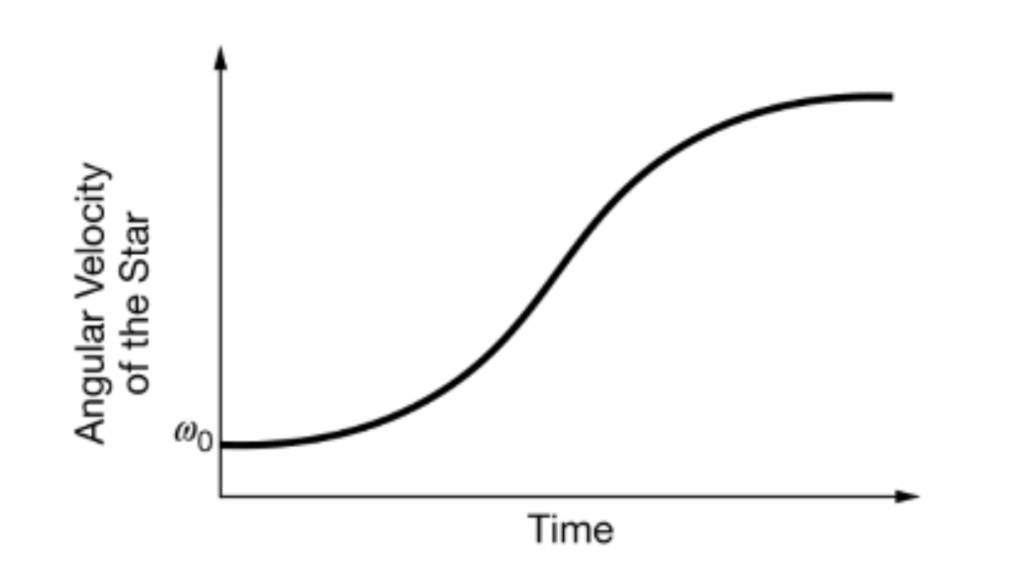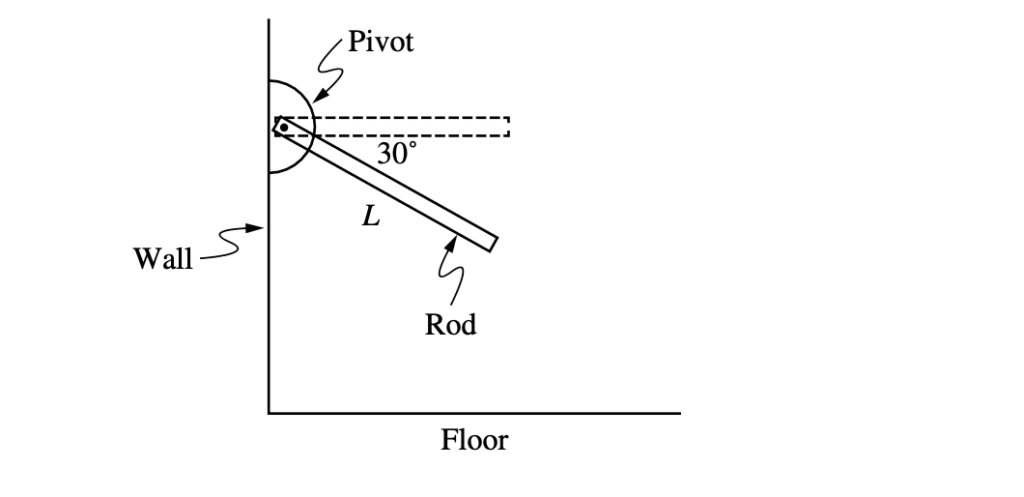0 attempts
0% avg
UBQ Credits
| Step | Derivation / Formula | Reasoning |
|---|---|---|
| General set-up | \(\begin{aligned} \text{Let}&:\;T_y&=T\sin\theta \,\;(\text{vertical component of tension})\\ H_y&=\text{vertical component of wall force we seek}\\ a&=\text{block position ( }a=L\text{ or }L/2)\\ b&=\text{cable position ( }b=L\text{ or }L/2)\;. \end{aligned}\) | All four arrangements differ only in the values of a and b. The beam’s own weight \(Mg\) acts at \(L/2\). Horizontal components are irrelevant for the vertical reaction. |
| Static equilibrium conditions | Torque about wall hinge: \(T_y\,b = Mg\,\frac{L}{2}+Mg\,a\) Vertical forces: \(H_y + T_y -2Mg = 0\Rightarrow H_y = 2Mg – T_y\) |
Taking torques about the hinge eliminates the unknown horizontal wall force. The horizontal component of tension passes through the hinge and produces no torque, so only \(T_y\) appears. |
| (A) Cable at \(L\), Block at \(L\) | \(\begin{aligned} T_y &= Mg\,\frac{\dfrac{L}{2}+L}{L}=1.5\,Mg\\ H_y &= 2Mg-1.5Mg = 0.5\,Mg \end{aligned}\) | The upward lift supplied by the cable is \(1.5Mg\); the wall therefore needs to supply only \(0.5Mg\) upward. |
| (B) Cable at \(\tfrac{L}{2}\), Block at \(L\) | \(\begin{aligned} T_y &= Mg\,\frac{\dfrac{L}{2}+L}{\tfrac{L}{2}} = 3\,Mg\\ H_y &= 2Mg-3Mg = -1\,Mg\quad\Rightarrow\;|H_y| = 1\,Mg \end{aligned}\) | The cable lifts more than the total weight, so the wall must push downward with magnitude \(Mg\). |
| (C) Cable at \(L\), Block at \(\tfrac{L}{2}\) | \(\begin{aligned} T_y &= Mg\,\frac{\dfrac{L}{2}+\tfrac{L}{2}}{L}=1\,Mg\\ H_y &= 2Mg-1Mg = 1\,Mg \end{aligned}\) | With the block moved inward the cable lifts less, so the wall must supply \(Mg\) upward. |
| (D) Cable at \(\tfrac{L}{2}\), Block at \(\tfrac{L}{2}\) | \(\begin{aligned} T_y &= Mg\,\frac{\dfrac{L}{2}+\tfrac{L}{2}}{\tfrac{L}{2}} = 2\,Mg\\ H_y &= 2Mg-2Mg = 0 \end{aligned}\) | The cable’s upward force exactly balances the two weights, leaving the wall with no vertical reaction. |
| Comparison | \(|H_y|_{(A)} = 0.5Mg,\; |H_y|_{(B)} = Mg,\; |H_y|_{(C)} = Mg,\; |H_y|_{(D)} = 0\) | The smallest magnitude of the wall’s vertical force is zero, obtained in option (D). |
Just ask: "Help me solve this problem."
Consider a rigid body that is rotating. Which of the following is an accurate statement?

An isolated spherical star of radius [katex] R_o [/katex], rotates about an axis that passes through its center with an angular velocity of [katex] \omega_o [/katex]. Gravitational forces within the star cause the star’s radius to collapse and decrease to a value [katex] r_o <R_o [/katex], but the mass of the star remains constant. A graph of the star’s angular velocity as a function of time as it collapses is shown. Which of the following predictions is correct about the angular momentum [katex] L [/katex] of the star immediately after the collapse?

A uniform rod of mass \( M_0 \) and length \( L \) is free to rotate about a pivot at its left end and is released from rest when the rod is \( 30^{\circ} \) below the horizontal, as shown in the figure. With respect to the pivot, the rod has rotational inertia \( I_0 = \dfrac{1}{3} M_0 L^2 \). Which of the following expressions correctly represents the magnitude of the net torque exerted on the rod about the pivot at the moment the rod is released?
Consider an object on a rotating disk at a distance \( r \) from its center, held in place on the disk by static friction. Which of the following statements is not true concerning this object?
An object moves at a constant speed of [katex] 9.0 \frac{m}{s} [/katex] in a circular path of radius of 1.5 m. What is the angular acceleration of the object?
By continuing you (1) agree to our Terms of Use and Terms of Sale and (2) consent to sharing your IP and browser information used by this site’s security protocols as outlined in our Privacy Policy.
| Kinematics | Forces |
|---|---|
| \(\Delta x = v_i t + \frac{1}{2} at^2\) | \(F = ma\) |
| \(v = v_i + at\) | \(F_g = \frac{G m_1 m_2}{r^2}\) |
| \(v^2 = v_i^2 + 2a \Delta x\) | \(f = \mu N\) |
| \(\Delta x = \frac{v_i + v}{2} t\) | \(F_s =-kx\) |
| \(v^2 = v_f^2 \,-\, 2a \Delta x\) |
| Circular Motion | Energy |
|---|---|
| \(F_c = \frac{mv^2}{r}\) | \(KE = \frac{1}{2} mv^2\) |
| \(a_c = \frac{v^2}{r}\) | \(PE = mgh\) |
| \(T = 2\pi \sqrt{\frac{r}{g}}\) | \(KE_i + PE_i = KE_f + PE_f\) |
| \(W = Fd \cos\theta\) |
| Momentum | Torque and Rotations |
|---|---|
| \(p = mv\) | \(\tau = r \cdot F \cdot \sin(\theta)\) |
| \(J = \Delta p\) | \(I = \sum mr^2\) |
| \(p_i = p_f\) | \(L = I \cdot \omega\) |
| Simple Harmonic Motion | Fluids |
|---|---|
| \(F = -kx\) | \(P = \frac{F}{A}\) |
| \(T = 2\pi \sqrt{\frac{l}{g}}\) | \(P_{\text{total}} = P_{\text{atm}} + \rho gh\) |
| \(T = 2\pi \sqrt{\frac{m}{k}}\) | \(Q = Av\) |
| \(x(t) = A \cos(\omega t + \phi)\) | \(F_b = \rho V g\) |
| \(a = -\omega^2 x\) | \(A_1v_1 = A_2v_2\) |
| Constant | Description |
|---|---|
| [katex]g[/katex] | Acceleration due to gravity, typically [katex]9.8 , \text{m/s}^2[/katex] on Earth’s surface |
| [katex]G[/katex] | Universal Gravitational Constant, [katex]6.674 \times 10^{-11} , \text{N} \cdot \text{m}^2/\text{kg}^2[/katex] |
| [katex]\mu_k[/katex] and [katex]\mu_s[/katex] | Coefficients of kinetic ([katex]\mu_k[/katex]) and static ([katex]\mu_s[/katex]) friction, dimensionless. Static friction ([katex]\mu_s[/katex]) is usually greater than kinetic friction ([katex]\mu_k[/katex]) as it resists the start of motion. |
| [katex]k[/katex] | Spring constant, in [katex]\text{N/m}[/katex] |
| [katex] M_E = 5.972 \times 10^{24} , \text{kg} [/katex] | Mass of the Earth |
| [katex] M_M = 7.348 \times 10^{22} , \text{kg} [/katex] | Mass of the Moon |
| [katex] M_M = 1.989 \times 10^{30} , \text{kg} [/katex] | Mass of the Sun |
| Variable | SI Unit |
|---|---|
| [katex]s[/katex] (Displacement) | [katex]\text{meters (m)}[/katex] |
| [katex]v[/katex] (Velocity) | [katex]\text{meters per second (m/s)}[/katex] |
| [katex]a[/katex] (Acceleration) | [katex]\text{meters per second squared (m/s}^2\text{)}[/katex] |
| [katex]t[/katex] (Time) | [katex]\text{seconds (s)}[/katex] |
| [katex]m[/katex] (Mass) | [katex]\text{kilograms (kg)}[/katex] |
| Variable | Derived SI Unit |
|---|---|
| [katex]F[/katex] (Force) | [katex]\text{newtons (N)}[/katex] |
| [katex]E[/katex], [katex]PE[/katex], [katex]KE[/katex] (Energy, Potential Energy, Kinetic Energy) | [katex]\text{joules (J)}[/katex] |
| [katex]P[/katex] (Power) | [katex]\text{watts (W)}[/katex] |
| [katex]p[/katex] (Momentum) | [katex]\text{kilogram meters per second (kgm/s)}[/katex] |
| [katex]\omega[/katex] (Angular Velocity) | [katex]\text{radians per second (rad/s)}[/katex] |
| [katex]\tau[/katex] (Torque) | [katex]\text{newton meters (Nm)}[/katex] |
| [katex]I[/katex] (Moment of Inertia) | [katex]\text{kilogram meter squared (kgm}^2\text{)}[/katex] |
| [katex]f[/katex] (Frequency) | [katex]\text{hertz (Hz)}[/katex] |
General Metric Conversion Chart
Example of using unit analysis: Convert 5 kilometers to millimeters.
Start with the given measurement: [katex]\text{5 km}[/katex]
Use the conversion factors for kilometers to meters and meters to millimeters: [katex]\text{5 km} \times \frac{10^3 \, \text{m}}{1 \, \text{km}} \times \frac{10^3 \, \text{mm}}{1 \, \text{m}}[/katex]
Perform the multiplication: [katex]\text{5 km} \times \frac{10^3 \, \text{m}}{1 \, \text{km}} \times \frac{10^3 \, \text{mm}}{1 \, \text{m}} = 5 \times 10^3 \times 10^3 \, \text{mm}[/katex]
Simplify to get the final answer: [katex]\boxed{5 \times 10^6 \, \text{mm}}[/katex]
Prefix | Symbol | Power of Ten | Equivalent |
|---|---|---|---|
Pico- | p | [katex]10^{-12}[/katex] | 0.000000000001 |
Nano- | n | [katex]10^{-9}[/katex] | 0.000000001 |
Micro- | µ | [katex]10^{-6}[/katex] | 0.000001 |
Milli- | m | [katex]10^{-3}[/katex] | 0.001 |
Centi- | c | [katex]10^{-2}[/katex] | 0.01 |
Deci- | d | [katex]10^{-1}[/katex] | 0.1 |
(Base unit) | – | [katex]10^{0}[/katex] | 1 |
Deca- or Deka- | da | [katex]10^{1}[/katex] | 10 |
Hecto- | h | [katex]10^{2}[/katex] | 100 |
Kilo- | k | [katex]10^{3}[/katex] | 1,000 |
Mega- | M | [katex]10^{6}[/katex] | 1,000,000 |
Giga- | G | [katex]10^{9}[/katex] | 1,000,000,000 |
Tera- | T | [katex]10^{12}[/katex] | 1,000,000,000,000 |
The most advanced version of Phy. 50% off, for early supporters. Prices increase soon.
per month
Billed Monthly. Cancel Anytime.
Trial –> Phy Pro
We crafted THE Ultimate A.P Physics 1 course so you can learn faster and score higher.
Try our free calculator to see what you need to get a 5 on the upcoming AP Physics 1 exam.
A quick explanation
Credits are used to grade your FRQs and GQs. Pro users get unlimited credits.
Submitting counts as 1 attempt.
Viewing answers or explanations count as a failed attempts.
Phy gives partial credit if needed
MCQs and GQs are are 1 point each. FRQs will state points for each part.
Phy customizes problem explanations based on what you struggle with. Just hit the explanation button to see.
Understand you mistakes quicker.

Phy automatically provides feedback so you can improve your responses.
10 Free Credits To Get You Started

By continuing you agree to nerd-notes.com Terms of Service, Privacy Policy, and our usage of user data.
NEW! PHY AI accurately solves all questions
🔥 Get up to 30% off Elite Physics Tutoring
🧠 NEW! Learn Physics From Scratch Self Paced Course
🎯 Need exam style practice questions?